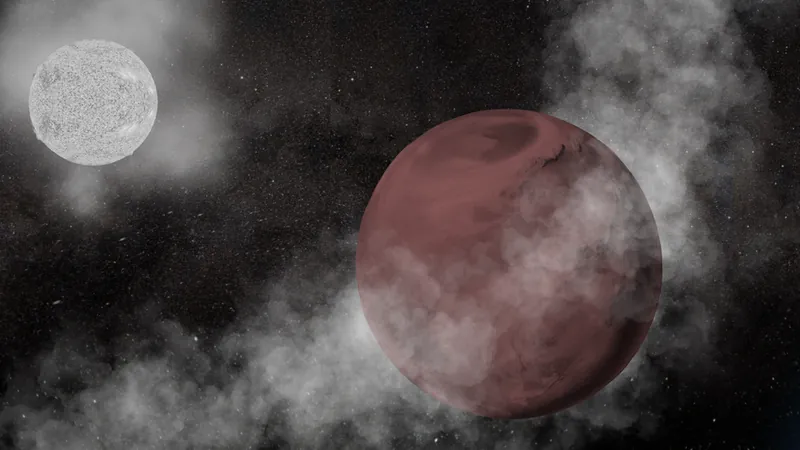
Future Earth: A Glimpse into Our Potential Fate Among the Stars
2024-09-26
Author: Lok
A Glimpse into Our Potential Fate Among the Stars
A groundbreaking discovery has unveiled a planetary system orbiting a dead white dwarf star located approximately 4,000 light-years away. This extraordinary find provides astronomers with a possible vision of what our sun and planet could resemble in about 8 billion years, contingent upon Earth's survival during a critical phase in our sun’s life cycle.
The Sun's Evolution and Earth's Fate
In roughly 5 to 6 billion years, our sun is predicted to evolve into a red giant. This phase will see it expand dramatically, potentially engulfing Mercury and Venus, and threatening the existence of Earth itself. However, there's a glimmer of hope; if Earth migrates outward to a position near Mars, it might escape destruction, transforming into a frigid, radiation-scorched remnant orbiting a dying star. This new discovery serves as evidence that such a 'miracle escape' is feasible.
The Discovery of the Planetary System
The team of researchers has identified a white dwarf with approximately half the mass of our sun and an Earth-sized planet orbiting at twice our distance from the sun. Analyses indicate that these celestial bodies can reflect what a surviving Earth could look like billions of years from now.
The Role of Brown Dwarfs
Notably, this system also includes a massive brown dwarf, a celestial body that doesn’t possess the mass necessary to initiate hydrogen fusion like our sun does. Situated near the central bulge of the Milky Way, this brown dwarf weighs about 17 times more than Jupiter, the largest planet in our solar system.
Microlensing Event
The team observed this planetary system during a 'microlensing event,' a phenomenon where the light from a distant star is magnified by the gravitational field of an object that lies between the star and Earth. This event, which occurred in 2020 and involved the brightening of a star located 24,000 light-years away, was captured by the Korea Microlensing Telescope Network. It served as a cosmic clue, pointing to the potential existence of the planetary system.
Confirming the White Dwarf
The research team, after extensive follow-up observations using the Keck Observatory telescopes in Hawaii, was able to confirm the central star's identity as a white dwarf through the lack of light typically emitted by a main sequence star. The gravitational effects and the light patterns illuminated the presence of the brown dwarf and other planetary bodies, leading to deeper insights into their configurations.
Challenges to Earth’s Habitability
Despite the tantalizing possibility of Earth surviving the sun’s transformation, researchers acknowledge the uncertainty surrounding life’s endurance during this period. Astrophysicist Jessica Lu from UC Berkeley notes, 'While it’s clear that Earth may not be engulfed by the sun, whether life could adapt and thrive during this transition remains unknown.'
Potential for Migration Away from Earth
The planetary system provides an intriguing case study of what could happen if Earth escapes consumption by the sun; however, it also implies that if Earth migrates outward, it would likely leave the habitable zone, the region where conditions permit liquid water—essential for life as we know it. Sadly, humanity may face a reckoning much sooner, as Earth’s habitability is expected to diminish significantly within the next billion years due to rising temperatures.
Future Human Habitation
Moving forward, researchers suggest that future humanity might consider migrations to the outer solar system, targeting moons like Europa or Enceladus, where the icy surfaces could potentially harbor liquid water beneath encompassing layers of ice. 'As the sun expands, the habitable zone will migrate outward as well,' said Keming Zhang, leading researcher on the study. 'This could open new doors for human habitation in the solar system.'
Implications for Exoplanet Research
The implications of this research extend beyond immediate survival strategies. It highlights the potential of microlensing as an invaluable tool for identifying and studying distant exoplanets. NASA's upcoming Nancy Grace Roman Telescope, set to launch in 2027, will make use of this method to explore planets beyond our solar system, paving the way for discoveries of various celestial configurations.
Conclusion
With every new discovery, we edge closer to understanding our place in the universe and the complexities of celestial mechanics. The future of Earth may still be undecided, but astronomers are continually working to shed light on the mysteries that lie ahead.





 Brasil (PT)
Brasil (PT)
 Canada (EN)
Canada (EN)
 Chile (ES)
Chile (ES)
 España (ES)
España (ES)
 France (FR)
France (FR)
 Hong Kong (EN)
Hong Kong (EN)
 Italia (IT)
Italia (IT)
 日本 (JA)
日本 (JA)
 Magyarország (HU)
Magyarország (HU)
 Norge (NO)
Norge (NO)
 Polska (PL)
Polska (PL)
 Schweiz (DE)
Schweiz (DE)
 Singapore (EN)
Singapore (EN)
 Sverige (SV)
Sverige (SV)
 Suomi (FI)
Suomi (FI)
 Türkiye (TR)
Türkiye (TR)